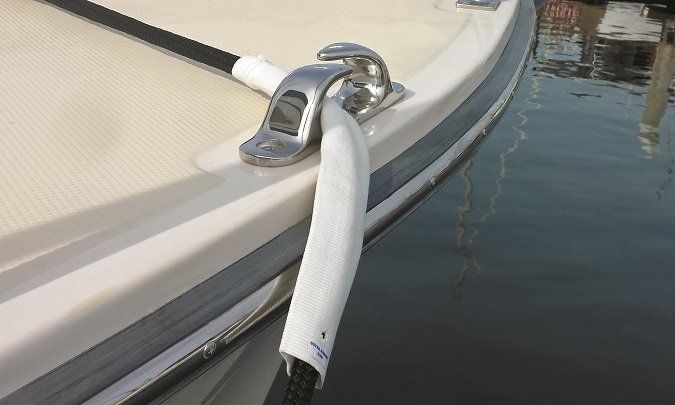It has been a while since we tested chafe gear (see PS October 2012), or since we described how to make your own chafe gear, so when Goyer Marine announced a new chafe gear product, we jumped on the chance to test it.
However, shortly after the following report was published, some readers notified us that Goyer no longer carried the product we had tested. Here is the explanation we received from Goyer.
Unfortunately we had to suspend production for now, as our chafe guard business failed to take off and bills were piling up. I am hoping it is temporary, and encourage everyone interested to go on our website and sign up for our email list. That way I can guage interest and look and getting back up and running in the near future.
Practical Sailor apologizes to readers for any inconvenience. If you don’t want to wait and see if Goyer gets production back up and running, there are other options.
Note that long-standing manufacturer of chafe gear, Fjord, does make a polyurethane-coated commercial version of a chafe protection product that we’ve tested rigorously. We have not yet tested the commercial version, but will be testing in the future. According to Fjord, this product offers a level of protection comparable to the Goyer products described below.
We hope Goyer can sort out their production issues.
For what it’s worth, here’s the rest of the description of the apparently discontinued Goyer product:
The weave is very similar to tubular climbing webbing, although made of polyester instead of nylon and with a slightly looser weave. Rainwater can permeate the Bulk Jacket Guard, cooling the rope and providing lubrication.
The HT and HE versions are treated with a resin that makes them far more wear resistant but effectively waterproof. All three products are nominally two inches wide and will accommodate ropes up to 1-inch.

FireHose Bulk Jacket
Soft, flexible, and easy to fit. Though fluffier than Bluewater tubular nylon climbing webbing (seePS November 2015), it measures the same thickness (~ 2 mm ) under light pressure from a micrometer. Although abrasion resistance was generally good, the looser weave allowed the cinder block to snag a thread and pull. 6 feet for $19.
Bottom line: Climbing webbing is more durable and a better value.
FireHose XT Custom Guard.
This is the same webbing as bulk firehose, but saturated with a polyurethane resin. The webbing becomes slightly stiffer and more wear resistant, placing it on a par with Bluewater webbing after coating with Maxijacket, but with less stiffness. This is a potent combination, perhaps the best compromise for off the shelf dock line chafe protection that weve seen yet. It sold in pre-cut lengths of 14 inches for $15, and 6 feet for $28.
Bottom line: Good for dock lines and for mooring pendants.
FireHose HE Custom Guard
A heavier dose of resin results in an even tougher guard. We even extended the test interval by four times, and still the webbing was barely scuffed.
The down side is that it becomes quite stiff, perhaps a little annoying to work with on docklines. That said, wed still choose it for tough applications because of the thin profile, and we like it a lot for mooring pendants.
If you wear through this, there is something very wrong with the lead. Eighteen inches for $25.
Bottom line: Good or mooring pendants and Recommended for heavy duty dockline situations.
Conclusion
A weakness of multi-layer and plastic tubing chafe guards is they are often too fat to fit into the chock, or at least weve always struggled with that. By the time we get the line size we want, there is hardly room for a guard. Single layer guards, like climbing webbing (preferably coated with Maxijacket) and Chafepro, solve this problem, eliminating any reason not to use them. Ever since weve improved the chafe gear in our ground tackle equation, we sleep better, knowing there is an extra layer protecting our snubbers or rodes.
[Note that this article is an update to the print version that appeared in the Sept. 2019 issue].






































